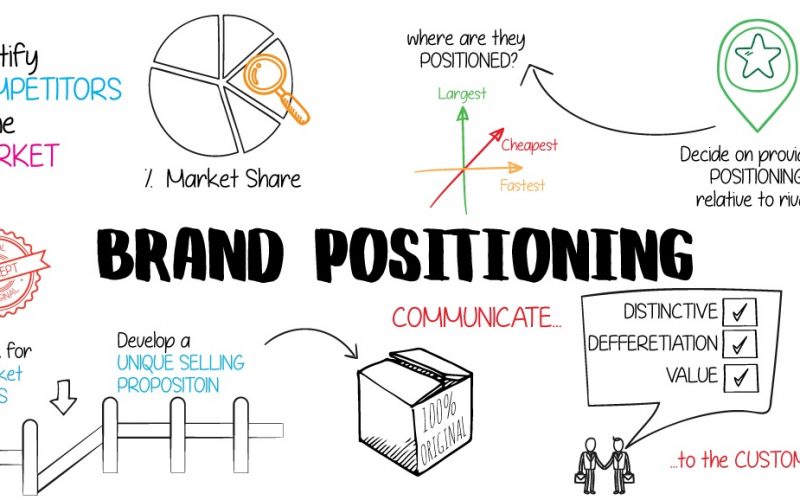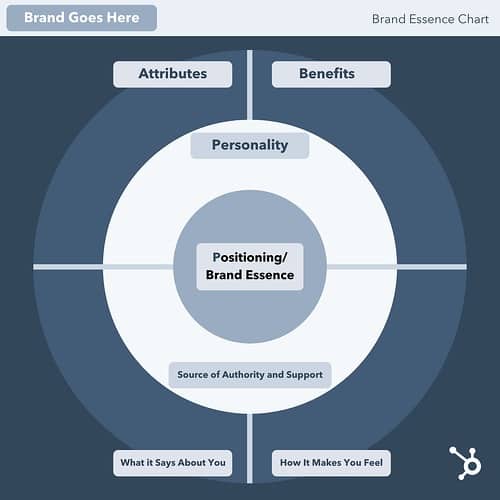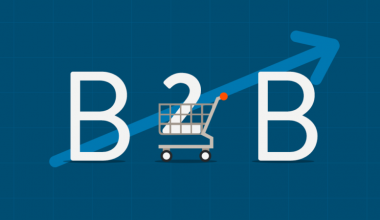You’ve probably heard of the concept of brand positioning if you’re a marketer or an entrepreneur. Well, this article is for you if you think this concept is still too vague and unclear. To a large extent, organizations that want to succeed often need a solid brand positioning strategy, and the evidence is in the numbers. Brands that are well presented enjoy a 10-20% boost in sales on average. And benefits of successful branding include increased consumer loyalty, a better image, and a relatable personality that sets you apart from the competitors. In the course of this post, you’ll learn the framework for positioning a brand successfully within your ideal market. The high-level issues we’ll cover are listed above; don’t worry, we’ll dig into the weeds so you have a firm grasp on effective brand positioning with a couple of strategies and examples.
What is Brand Positioning?
Simply put, this is the process of establishing your brand in the minds of your customers. However, unlike the popular misconception, brand positioning is more than a catchphrase or a flashy logo; it’s a strategy for distinguishing your company from the competition.
When a brand is viewed as positive, valuable, and believable by the consumer, it is said to be effectively positioned. As a result, your customers carve out a place in their imaginations for you as a result of the combination of those three.
This is critical since simply being “unique” or “different” from the competition isn’t enough to succeed in business. Take it from Will Barron, a brand positioning expert at Salesman.org:
“When you’re doing something amazing, you only get the chance to position your brand. Anything else is merely a comparison.”
What is the Significance of Brand Positioning?
You already have a reputation, whether you like it or not, but what’s more important is creating a brand positioning strategy to assist you to take control of your brand image and reputation.
Let’s take a look at one of the numerous simple but practical brand positioning examples;
A soda firm chose to provide a never-before-seen product more than a century ago: the first-ever cola drink. It was able to establish itself as the original in this way. Coca-Cola has become a household staple with millions of sales all over the world. It’s regarded as the gold standard of soda in our minds.
In other words, a company’s brand positioning allows it to stand out from the competition. This differentiation aids a company in raising brand awareness, communicating value, and justifying pricing; all of which have an impact on the bottom line.
However, not all brand positioning strategies are created equal or have the same goal. Your positioning and messaging will differ depending on the nature of your business and industry. Let’s take a look at some basic positioning strategies and examples to get you started.
Brand Positioning Strategies: What Are They and How Do They Work?
You have various alternatives when it comes to determining how to position your brand in the marketplace. Basically, you want to adjust your strategy to highlight your product’s competitive edge while highlighting the flaws of your competitors.
Here are a few prominent brand positioning strategies that you can employ to set your business out from the competition.
Customer Service Brand Positioning Strategy
At some point in your life, you’ve probably chosen a merchant, restaurant, or other service provider based on their customer service.
Companies in verticals where negligent customer service is a problem benefit from emphasizing on their nice customer service to set themselves apart. Other businesses, particularly those with more sophisticated products, can use their strong support systems to attract new customers.
Furthermore, great customer service can help justify a higher price level, which is the biggest tangible benefit of this brand positioning strategy. Apple’s products, for example, are expensive, but the company’s support staff is courteous and quick to +answer.
These service contacts are also an important element of the flywheel; if a consumer has a positive service experience, they may become a promoter.
However, ensure you use this technique with caution. If you promise excellent customer service but don’t follow through, you’ll get terrible reviews, angry phone calls and emails, and social media shout-outs.
Convenience-Based Brand Positioning Strategy
Convenience-based positioning strategies emphasize why a company’s product or service is more user-friendly than its competitors. Major contributors to this technique include; location, ease-of-use, extensive accessibility, and compatibility with numerous platforms.
The product’s design may also contribute to convenience. Swiffer, for example, promotes its WetJet mopping system as a convenient alternative to a regular mop due to its disposable mopping pads.
When you position your product or service as the most convenient, it will instantly appeal to busy people. And like the customer service strategy, it can also justify a higher price level. A Swiffer WetJet, for example, costs $26, while an O-Cedar mop only $10.
However, providing convenience might be costly in some cases. For example, if you’re in the B2B SaaS area and want to offer your product on several operating systems, you’ll almost certainly need a robust, always-available development team to keep your promise.
The last thing you should look into is whether your product is genuinely convenient. Customers may find the WetJet mop inconvenient because they must return to the store to purchase refills on a regular basis. If you marketed a similar product, you might want to consider offering automatic refill programs or subscriptions to meet your customers’ convenience expectations.
Price-Based Brand Positioning Strategy
To market its product or service as the most cost-effective choice, a business adopts a price-based positioning strategy. Because no one loves to spend more than they have to, positioning your product as the cheapest on the market might help you attract a wide consumer base. In other words, it’s simple to convert prospects by offering the lowest price.
However, there are several dangers and drawbacks to this method, including reflecting a lesser production quality to prospects. This means that you could end up giving off the impression that your products have lesser quality compared to your competition’s.
You can also run into financial difficulties that impede your brand’s long-term standing, such as Subway’s $5 footlong, which couldn’t withstand inflation. Price-based positioning can also spark a price war. This is more common in certain areas like air travel.
Quality-Based Brand Positioning Strategy
When a company wants to stress the quality of their product they use this method.
A product’s quality can be demonstrated by great craftsmanship, small-batch production, high-quality materials, and even environmentally friendly procedures that make it more expensive to manufacture. Evidence of great end results, significant ROI, and glowing client testimonials can all be used to demonstrate service excellence.
However, budget-conscious customers may choose to avoid your brand in favor of a less expensive alternative. Buyer personas, on the other hand, would be useful in this situation. Whether emphasizing quality (with a greater premium) is the best option for your business depends on the income and purchasing habits of your target clients.
Differentiation Brand Positioning Strategy
In comparison to the traditional competition, a differentiation positioning approach emphasizes on a product’s distinctiveness or new traits. Tesla is a good example of this.
There was no appealing, totally electric automobile available for purchase prior to the Tesla models. It is now the world’s leading tech company in the development of self-driving cars and AI robots.
Consumers that value innovation will be drawn to your brand and product if you adopt this strategy. One potential drawback, however, is that the audience may be put off by the lack of prior experience. If your product is brand new, include the research and testing that went into its development. Consumers who are interested in new technology or products frequently want to know how they work.
Social Media Brand Positioning Strategy
To a large extent, this strategy is distinctive because it focuses on a group of channels rather than being a stand-alone technique. Plus the channels your company utilizes (or disregards) are just as important as the messages it sends out.
Your brand doesn’t have to be present on every platform, believe it or not. The key to this technique is to select the channels that your target market uses the most. When selecting a social media platform for your marketing strategy, keep the following aspects in mind:
- Where does your target market spend their free time?
- What and Where does your target market spend their money?
- Where does your target audience go to acquire advice and information?
These three pieces of information could all be located on one social network, but they could also be distributed across numerous. You may tailor your messaging to meet the customer where they are once you’ve narrowed down where your brand should appear.
Other Positioning Techniques
These aren’t the only options available. Your brand can be positioned as the market leader, the first of its kind (the pioneer), or the most popular. You can also sell your product as a remedy to a widespread problem.
Another strategy is to compare your brand to that of your competitors. In this technique, you’d use your marketing campaigns to directly criticize your competitors and highlight the benefits of your product over theirs.
But then you’d need to take a thorough look at your target buyers and their behaviors when drafting your viewpoint. How you position your business will depend on whether they desire to save money, spend money on quality, or have the latest or the best device.
Now that you’ve had a sense of the several techniques you might take, it’s time to develop a brand positioning strategy that puts your brand as the friendliest, most convenient, cheapest, or simply the best option among competitors.
How to Develop a Brand Positioning Strategy
Developing your own brand positioning plan entails delving into the nitty-gritty of your business and figuring out what you do better than anybody else. These stages will assist you in developing a brand positioning plan that is specific to your company.
#1. Determine the Present Position of Your Brand
Are you currently selling your product or service as if it were just another commodity on the market, or as something unique? Your present brand positioning might help you figure out where you should go next. Basically, to study your competitors further, you must first understand your existing position.
Begin by thinking about and defining your target customer. Next, determine your mission, values, and what sets you apart from the competition. Finally, evaluate your value proposition, as well as your current brand persona and voice.
According to Matylda Chmielewska of the LiveChat Partner Program,
“We all want to interact with brands that seem and feel genuine. So instead of inventing complicated jargon that no one will understand, just speak plainly. Begin by determining who your (ideal and existent) target audience is and speaking in their language.”
#2. Design a chart of your Brand’s Essence
It’s time to delve into the nitty-gritty of what your brand represents to customers once you’ve defined where it stands in the market. A brand essence chart can aid in the organization of these concepts, making them more clear and simple. This chart can also be used for copywriting and design inspiration.
There are seven parts to the brand essence chart:
- Attributes — Consider attributes to be features. This might be a little easier to come up with for a physical product than for a SaaS or technological offering.
- Benefits — What does the customer gain out of your product or service as a result of its features?
- Personality — This describes your brand’s traits. Also, don’t be scared to use a thesaurus for this section. To set your business apart from the competition, your personality may and should be comprehensive.
- Source of Authority and Support — What is your brand’s foundation? It might be a long history of industry knowledge, awards and regulatory recognition in your vertical, scientific research, or even unwavering consumer support in the form of reviews and testimonials.
- What It Says About You (The Client) — What does your brand say about your ideal customer based on the aspects we’ve explored so far? To help you complete this section, draw inspiration from the personality section.
- How It Makes You Feel (As A Customer) — What terms or phrases might your ideal customer use to describe their feelings while interacting with your brand? This section of the brand essence chart will assist you in determining a niche message angle for your company.
Finally, you’ll connect all of these pieces together to form a clear statement that explains what the buyer should take away from your business. This is not to be mistaken with a formal positioning statement.
#3. Determine Who Your Competition Are
After you’ve analyzed yourself, it’s time to look at your competition with competitor analysis. Why? Well, that’s simple, you need to know who you’re up against. This research will help you in determining what you can improve in your plan to gain an advantage.
There are a variety of ways to figure out who your competitors are, including:
Ask your sales team about any competitors that come up during the sales process, or perform a quick search using a market phrase to see which organizations are mentioned.
Use Customer feedback — Inquire of your consumers about other firms or goods they considered before concluding on yours.
Use Social Media — Quora is a website that allows customers to ask questions about products and services. Find competition in your niche by searching these forums.
#4. Conduct a Competitive Analysis
It’s time to undertake in-depth competitor research once you’ve discovered who your competitors are. In order to compete, you’ll need to look at how your competitors are positioning their brands. At its most basic level, your study should comprise the following:
- What services or goods do your rivals provide?
- Exactly what are their advantages and disadvantages?
- What successful marketing methods are they employing?
- What is their current market position?
#5. Determine Your One-Of-A-Kind Value Offer
Creating a distinct brand is all about figuring out what makes you stand out and what works best for your company. “Start by establishing what ‘effective’ really means for your company — and then develop its image based on that,” Chmielewska advises.
You’ll probably notice patterns after conducting competitor analysis. You’ll notice that various companies have similar strengths and shortcomings. When you compare your product or service to theirs, you can discover that one of their flaws is also one of yours.
This is what makes your brand unique, and it’s a great place to start when it comes to market positioning. As you compare, take note of your distinct offerings and dig deep to discover what you do better than anyone else.
#6. Create a Framework for Brand Positioning
It might be difficult to emphasize a primary message when positioning a brand because there are so many touchpoints. A brand positioning framework will aid your brand positioning strategy.
This paradigm takes a touch-down approach, beginning with the main idea and ending with sample touchpoints that can be used in tactical situations such as social media captions, blog article headlines, and ad content.
#7. Write a Your Business’s Positioning Statement
Now is the moment to put all you’ve learned into a brand positioning statement.
“A positioning statement is a one- or two-sentence proclamation that communicates your brand’s distinctive value to your clients in respect to your primary competitors,” according to The Cult Branding Company.
Before drafting your positioning statement, consider the following four questions:
- What is the nature of your product or service?
- Who is your ideal client?
- What is the most significant advantage of your product or service?
- What evidence do you have that this benefit exists?
You can then create a basic yet effective positioning statement. Take Amazon’s positioning statement, for example:
“Our vision is to be the world’s most customer-centric company; to provide a destination where people can come to search and discover everything they would want to buy online.”
Basically, anyone and everyone is Amazon’s target consumer; an enormous scope. Their main benefit is that they sell a wide choice of things for everyone. And what about the proof? It’s all done over the internet.
#8. Check to See if Your Positioning Statement Is Effective
Taking the time to position your brand in a way that appeals to a certain buyer is only the start. After you’ve established your positioning statement, it’s time to put it to the test, experiment with it, and get feedback from your customers to see if it meets its aim.
According to Ryan Robinson of Close.io,
“Only a small part of the struggle is devoting time and effort to positioning your brand to appeal to a specific vertical, type of consumer, or demographic.
“It’s critical to test, experiment, and actively acquire (genuine) feedback from your target clients to see if your positioning is actually working.
#9. Make an Emotional Connection With Potential Customers and Clients
Connecting with your prospects on an individual level before going for the hard sale develops trust and helps them have a better experience with your company’s brand. Reps should, for example, spend time learning about your prospects and the problem they’re trying to solve with your product at the start of the sales process.
#10. Emphasize Your Brand’s Distinguishing Characteristics During the Sales Process
The unique qualities of your company’s offering should be easy to comprehend and refer to if you have a solid brand position. Throughout the sales process, make sure your prospects understand what makes your brand special.
#11. Make Sure Your Employees Are Brand Ambassadors
Employees that interact with customers are your company’s most important ambassadors. Prospects should have an experience that reflects your company’s basic principles and is consistent with its brand. If your company’s branding is lighthearted and playful, for example, you should use this kind of language in your sales pitches. A tone that is extremely serious or rigid will not consistent with your company’s brand in this case.
Examples of Brand Positioning
Many organizations have excelled at brand positioning over the years by developing a positioning strategy that outperforms the competition. The following are five great examples:
Tinder vs. Bumble
Bumble was founded in 2014 by Whitney Wolfe after she left Tinder. It was positioned as an app that empowered women to take charge while meeting new people.
Bumble has extended beyond the dating category, providing users the ability to find friendship and professional connections within the platform, in addition to its initial focus on improving the female user experience. Tinder, on the other hand, is all about making quick connections.
But then the differentiating factor is Bumble’s positioning strategy. “Bumble was first formed to disrupt the old rules of dating,” the company says on its website. Indeed, it took a different strategy than any other app, with women taking the lead rather than males.
Tinder’s positioning strategy, on the other hand, is leader-based, with the brand relying on its long history and widespread popularity to entice others to join. Though the brand does not explicitly state that it is a leader in online dating (a tone that would be out of place in the sector), it does imply that it is by stressing its large user base and nearly decade-long history.
Dunkin’ Donuts vs. Starbucks
While Starbucks and Dunkin’ may appear to be distinct, they both cater to customers who go for a morning coffee run. Starbucks’ brand is built around the in-store experience. Dunkin’s, on the other hand, is built around its two main products: coffee and donuts. “American Runs on Dunkin” is the company’s motto, emphasizing the breadth of its product offerings. Starbucks, on the other hand, emphasizes craft and provides a more typical coffee shop environment.
Positioning Strategy of Starbucks vs. Dunkin’ Donuts
The bright pink and orange colors of Dunkin’ Donuts contrast sharply with Starbucks’ green and brown branding. It’s reflected in their strategies as well.
The focus of Starbucks’ strategy is on quality. “Our coffee gurus have reduced their years of tasting knowledge down to three easy questions to help you select a Starbucks coffee you’re likely to love,” the business says on its Coffee Finder page. This type of language demonstrates Starbucks’ preference for quality over quantity and even availability.
Dunkin’ focuses on both field leadership and broad availability, thus their strategy is both leader- and convenience-driven. “Dunkin’ is the world’s leading baked goods and coffee business, serving over 3 million people every day,” the brand claims, emphasizing how simple it is to pop by for a cup of coffee.
Apple Music vs. Spotify
The Spotify versus. Apple Music debate has gotten a lot of media attention. If you check it up on Google, the news area alone returns almost twenty-six million results.
Spotify is known for its high level of personalization, but Apple Music is known for its higher-quality song collection and, of course, the Apple brand. Despite the fact that their products are startlingly similar, both brands pursue market positioning in very different ways.
The Positioning Strategy of Spotify vs. Apple Music
Spotify employs a pricing model. While its premium alternatives are roughly equal in terms of pricing to Apple Music’s, it does offer a free plan that makes it more accessible.
Apple Music takes a quality-first approach, emphasizing its 60-million-song archive as a major draw. It also has exclusive content, such as videos and lyrics displayed on the screen. Spotify, on the other hand, only has this capability for a few tracks.
Popeyes vs. Chick-Fil-A
One thing that Popeyes and Chick-Fil-A have in common is fried chicken. Aside from that, the brands could not be more dissimilar. Popeyes specializes in down-home, southern, cajun-style cuisine that will give your lunch hour a boost. On the other side, Chick-Fil-A avoids the edgy feel and instead serves wholesome, well-rounded favorites that everyone in the family will enjoy every day save Sunday.
Positioning Strategy of Popeyes vs. Chick-Fil-A
Popeyes has a differentiation strategy, while Chick-Fil-A promotes a hybrid customer service/quality-based strategy. Chick-Fil-A stands out because its brand positioning strategies are both overt and subtle. The company rarely brags about its excellent customer service the way it brags about the quality of its sandwiches and salads – instead, the company lets the employees’ actions speak for themselves.
On the other hand, Popeyes isn’t in the business of providing great customer service; they’re on par with other fast-food competitors. However, the company stands out as a run-of-the-mill fast-food restaurant that can hold its own against the industry gold standard, Chick-Fil-A.
Target vs. Walmart
This long-running battle is a perfect illustration of workplace brand positioning strategy. However, because there are significantly more Walmart stores across the country, geography may be a barrier for some customers who want to test the Target brand. But, for the most part, these two retail giants are deserving of their market share.
Positioning Strategy of Target vs. Walmart
Walmart has established itself as the industry standard for fast and low-cost shopping for everything from groceries to car parts. Target adopted two of the mega-strategies: retailer’s quality-based positioning and customer service positioning.
“Both stores sell the same things, so what’s the difference?” you might argue. Target customers will eagerly point to Walmart’s seemingly longer lines and less arranged aisle shelves as evidence of a less-than-stellar shopping experience. On the other hand, customers value the low pricing and convenience of having a Walmart store just a few streets away.
Venmo vs. Cashapp
Cashapp and Venmo have established themselves as cultural icons in their own right. Both names are linked with the phrase, “I’ll pay you back later,” but with these applications, you can rest assured that your pals will honor their promises by making a request for the dollars you owe. While both platforms are often used by personal money lenders and borrowers, there is a preference for one over the other depending on brand positioning efforts.
Positioning Strategy for Cashapp vs. Venmo
The primary goal of Cashapp is to get money from point A to point B as quickly as possible. The app’s home screen, which prompts the user to enter a dollar amount before anything else, is where the company leads their convenience positioning campaign.
Venmo, on the other hand, prioritizes the connection over the transactional side of giving and receiving money. Venmo’s home screen replaces the transactional screen with a history of all fund transfers sent among your friends. Venmo’s social media positioning approach isn’t limited to the app; the company often hosts giveaways on Instagram, where its younger population spends the majority of their time.
Bowflex VeloCore vs. Peloton
If you thought the at-home stationary bike business was a monopoly, think again. Peloton has led the way in this area of the at-home fitness equipment market for the last few years. Despite the fact that the company isn’t new, it is one of the most up-and-coming in the market, and it is making seasoned competitors like Bowflex sweat.
VeloCore Positioning Strategy: Peloton vs. Bowlfex
Peloton’s brand appeals to younger consumers with greater disposable income to spend on workouts by combining convenience with social media positioning methods. The company has kept a close eye on market trends and has responded with products and services that appear to be in real-time.
Bowflex VeloCore recognizes that the Peloton buzz hides a high price point that keeps many people out of the market, so it competes on price instead. The brand essence chart for Bowflex VeloCore will appear radically different from one for Peloton if they have a comparable, and in some cases, better product.
Zoom vs. Google Meet
The year 2020 saw a significant shift in the way we lived and worked. Platforms like Google Meet and Zoom were at the top of everyone’s minds because virtual connection had become the new normal. While they both serve the same function — bringing people together over the internet — their positioning is vastly different.
Positioning Strategy for Google Meet vs. Zoom
Because both Google and Zoom require an app to function effectively and offer free but restricted platform usage, they have a comparable quick time to rate metric. However, while Zoom dominated the media as the go-to answer for work-from-home meetings, Google Meet wasn’t far behind as a connect-from-home option for relatives and friends who couldn’t get together in person. As a result, when compared to Zoom’s convenience-based branding, which became a saving grace for lonely professionals, Google’s brand positioning strategy focused more on identifying itself as a tool for the interactive socialite.
Other Examples of Strong Brand Positioning
Below are a couple of other brand positioning examples we could learn from.
#1. Tesla
Tesla is a high-end brand with a higher price tag than its competitors. As a result, they focus on the quality of their automobiles rather than the price of their vehicles in their branding. Tesla automobiles are premium vehicles that are also long-range, and eco-friendly.
Tesla’s automobiles are electric, which sets them apart from conventional gas-powered luxury vehicles. They set themselves apart from regular electric vehicles by offering higher-quality automobiles with longer ranges.
Tesla created a unique market for itself, as well as a fun brand to go with it. Elon Musk, the company’s CEO, has established himself as a Tony Stark-like figure, and the company touts its distinctiveness through advertisements and eccentric features like “Ludicrous Mode.”
#2. Apple
Apple is a textbook example of a successful brand. They’re the first example in Simon Sinek’s Golden Circle structure, which asks why, then how, and finally what.
Apple creates stunning, inventive computers that are unlike anything else you’ve seen before, and then promotes them to resonate with their customers.
Apple’s brand emphasizes the same attributes in their customers as they do in their products: being an Apple customer means being original, imaginative, and creative.
Apple, like Tesla, does not include pricing in their branding but instead emphasizes the value of their products and the relationship they have with its customers.
#3. Trader Joe’s
Trader Joe’s has set itself apart from the competition by branding itself as a “national chain of community grocery stores.” They provide a more intimate corner store shopping experience than competitors in the premium food space, such as Whole Foods.
They offer a large range of high-quality food at reasonable prices and strive to make shopping enjoyable. From in-store signage to the Hawaiian shirts their personnel wear to the terminology they use on their website, their nautical theme is represented across their assets.
“If an item doesn’t pull its weight in our stores, it goes away to gangway for something else,” they state on their website. That one line encapsulates their commitment to providing value to customers by providing high-quality products at reasonable costs in an entertaining environment.
#4. Dollar Shave Club
Dollar Shave Club’s name alone illustrates one of the most important components of their value proposition: their low cost. It has built a brand that is accessible to the average consumer by emphasizing price and convenience.
Dollar Shave Club is more playful and casual than its competitor Gillette, which is more expensive and has a very masculine tone to its advertising and branding. Gillette has an extremely elegant appearance and showcases men who appear to be actors or models. Dollar Shave Club uses persons of a variety of ages who are more relatable to the general public.
Dollar Shave Club’s brand is less expensive, more daring, and more convenient than its competitors.
#5. Nike
Nike began by emphasizing performance and innovation in their goods. They designed the waffle shoe and targeted serious athletes with their brand. Their product line has expanded beyond shoes to include athletic apparel that improves performance.
From their catchphrase “Just Do It” to their namesake, the Greek Goddess of Victory, their branding and marketing centers on empowerment.
Nike’s brand is built on the idea of innovation for dedicated athletes, so you can always perform at your best.
#6. HubSpot
HubSpot developed the phrase “inbound marketing” and based its company on it. They built their platform on the idea of providing useful material that attracts visitors to your website.
Their platform is effective, user-friendly, and focused on the client.
HubSpot began as an email marketing automation tool and has since grown into an all-in-one platform including marketing automation, CRM, sales, and customer service. They’ve grown to fit the requirements of their customers, emulating the customer-centric attitude that their flywheel preaches.
#7. Drift
Drift invented the phrase “Conversational Marketing” and developed a platform that focuses on a different component of marketing than any other technology available.
It focuses on human-to-human interactions in sales, unlike other technologies in the sector that are focused on automation, efficiency, and scalability. People buy from other people, and Drift’s brand is built on the notion that today’s most crucial aspect of sales is human interaction.
They published a book called “This Won’t Scale” on their philosophy, in which they explained how they were able to succeed by putting people over efficiency.
Drift is attempting to reimagine the B2B buying experience because, while automation allows marketers to sell to a broader audience, it does not make customer interactions any faster. Although conversational marketing is more difficult to scale, it improves the customer experience.
How Can You Improve Your Brand’s Positioning?
The positioning of your brand should be dynamic. This doesn’t mean you have to overhaul it every year, but you should look at it at least once a quarter to see how you can improve it.
Here are three suggestions for enhancing your brand’s positioning:
Don’t Construct Your Brand Positioning in a Vacuum; Instead, Listen to Your Customers
Make sure you’re paying attention to what your customers have to say if you want it to resonate with them. Set up focus groups, distribute questionnaires, or simply talk to customers at events to get feedback and refine your message.
Refocus Your Statement
Is your brand positioning attempting to be all things to all people? Have you lost sight of the one or two characteristics that actually distinguish you?
If your statement has lost its emphasis, go back to the beginning and evaluate if it is still successful by revisiting your initial study (or conducting fresh research).
Create a Buzz
If you’re a small business that’s just getting started, you might not have a large enough audience to test your brand positioning. Run some paid ads to A/B test a control statement (maybe a general statement about your firm) versus your brand positioning statement to observe how people react.
What Is Brand Positioning?
Simply put, this is the process of establishing your brand in the minds of your customers. However, unlike the popular misconception, brand positioning is more than a catchphrase or a flashy logo; it’s a strategy for distinguishing your company from the competition.
What Is an Example of Brand Positioning?
Let’s take a look at one of the numerous simple but practical brand positioning examples;
A soda firm chose to provide a never-before-seen product more than a century ago: the first-ever cola drink. It was able to establish itself as the original in this way. Coca-Cola has become a household staple with millions of sales all over the world. It’s regarded as the gold standard of soda in our minds.
What Are Brand Positioning Strategies?
Finding the correct location for a brand in the market as well as in the minds of consumers is the goal of brand positioning strategies. Companies must consider the following factors for good brand positioning: target consumer, primary competitors, point of similarity with competitors, and point of distinction with competitors.
What Is the Importance of Brand Positioning?
Clarity about who you serve is created by brand positioning. It also tells your target audience why you are the finest company for them and what distinguishes your products or services. It aids in the justification of your pricing strategy. The brand’s positioning might be used to justify a price strategy.
What Are the Characteristics of Brand Positioning?
Reliability, performance, efficiency, sustainability, beauty, and originality – these are all traits that assist develop a unique positioning for a product. Placing your goods based on these attributes enables people to form a brand image based on what your product can provide.
What Are the Benefits of Positioning?
Positively represents your brand or product: In marketing, positioning allows you to influence how people perceive your product. Customers may associate you with the product if you generate materials that portray it in a positive light, which can lead to more purchases.
Conclusion
As you can see, having a strong brand when entering or competing in any market makes all the difference. Making a statement, capturing (and maintaining) your target audience’s attention, and successfully building your brand all require a unique brand positioning strategy. So, to position yourself at the winning spot of your target market, use the brand positioning strategies and frameworks discussed in this article.
Related Articles
- The Product Life Cycle Theory: Guide to the Stages & Examples
- Business Strategy: Levels of Business Strategy+10 Best Business Strategy Examples
- FINANCIAL STATEMENT OF A COMPANY: Best 2023 Samples & Templates to Learn From
- Sustainable Competitive Advantage: Simple Steps to Gain a Sustainable Competitive Advantage







